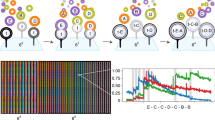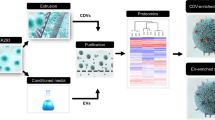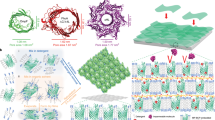Abstract
In cells, myriad membrane-interacting proteins generate and maintain curved membrane domains with radii of curvature around or below 50 nm. To understand how such highly curved membranes modulate specific protein functions, and vice versa, it is imperative to use small liposomes with precisely defined attributes as model membranes. Here, we report a versatile and scalable sorting technique that uses cholesterol-modified DNA ‘nanobricks’ to differentiate hetero-sized liposomes by their buoyant densities. This method separates milligrams of liposomes, regardless of their origins and chemical compositions, into six to eight homogeneous populations with mean diameters of 30–130 nm. We show that these uniform, leak-resistant liposomes serve as ideal substrates to study, with an unprecedented resolution, how membrane curvature influences peripheral (ATG3) and integral (SNARE) membrane protein activities. Compared with conventional methods, our sorting technique represents a streamlined process to achieve superior liposome size uniformity, which benefits research in membrane biology and the development of liposomal drug-delivery systems.

This is a preview of subscription content, access via your institution
Access options
Access Nature and 54 other Nature Portfolio journals
Get Nature+, our best-value online-access subscription
$29.99 / 30 days
cancel any time
Subscribe to this journal
Receive 12 print issues and online access
$259.00 per year
only $21.58 per issue
Buy this article
- Purchase on Springer Link
- Instant access to full article PDF
Prices may be subject to local taxes which are calculated during checkout




Similar content being viewed by others
Data availability
Source data are provided with this paper. The data (TEM images, gel and blot images, fluorescence traces and statistical data) supporting the findings of this study are available within the paper and its Supplementary Information files.
References
McMahon, H. T. & Gallop, J. L. Membrane curvature and mechanisms of dynamic cell membrane remodelling. Nature 438, 590–596 (2005).
Jarsch, I. K., Daste, F. & Gallop, J. L. Membrane curvature in cell biology: an integration of molecular mechanisms. J. Cell Biol. 214, 375–387 (2016).
Woodle, M. C. & Papahadjopoulos, D. Liposome preparation and size characterization. Methods Enzymol. 171, 193–217 (1989).
Schubert, R. Liposome preparation by detergent removal. Methods Enzymol. 367, 46–70 (2003).
Patil, Y. P. & Jadhav, S. Novel methods for liposome preparation. Chem. Phys. Lipids 177, 8–18 (2014).
Berger, N., Sachse, A., Bender, J., Schubert, R. & Brandl, M. Filter extrusion of liposomes using different devices: comparison of liposome size, encapsulation efficiency, and process characteristics. Int. J. Pharm. 223, 55–68 (2001).
Szoka, F. et al. Preparation of unilamellar liposomes of intermediate size (0.1–0.2 mumol) by a combination of reverse phase evaporation and extrusion through polycarbonate membranes. Biochim. Biophys. Acta 601, 559–571 (1980).
Hinna, A. et al. Filter-extruded liposomes revisited: a study into size distributions and morphologies in relation to lipid-composition and process parameters. J. Liposome Res. 26, 11–20 (2016).
Silva, R., Ferreira, H., Little, C. & Cavaco-Paulo, A. Effect of ultrasound parameters for unilamellar liposome preparation. Ultrason. Sonochem. 17, 628–632 (2010).
Goormaghtigh, E. & Scarborough, G. A. Density-based separation of liposomes by glycerol gradient centrifugation. Anal. Biochem. 159, 122–131 (1986).
Lundahl, P., Zeng, C. M., Lagerquist Hagglund, C., Gottschalk, I. & Greijer, E. Chromatographic approaches to liposomes, proteoliposomes and biomembrane vesicles. J. Chromatogr. B 722, 103–120 (1999).
van Swaay, D. & deMello, A. Microfluidic methods for forming liposomes. Lab Chip 13, 752–767 (2013).
Jahn, A., Vreeland, W. N., Gaitan, M. & Locascio, L. E. Controlled vesicle self-assembly in microfluidic channels with hydrodynamic focusing. J. Am. Chem. Soc. 126, 2674–2675 (2004).
Jahn, A., Vreeland, W. N., DeVoe, D. L., Locascio, L. E. & Gaitan, M. Microfluidic directed formation of liposomes of controlled size. Langmuir 23, 6289–6293 (2007).
Yang, Y. et al. Self-assembly of size-controlled liposomes on DNA nanotemplates. Nat. Chem. 8, 476–483 (2016).
Zhang, Z., Yang, Y., Pincet, F., Llaguno, M. C. & Lin, C. X. Placing and shaping liposomes with reconfigurable DNA nanocages. Nat. Chem. 9, 653–659 (2017).
Perrault, S. D. & Shih, W. M. Virus-inspired membrane encapsulation of DNA nanostructures to achieve in vivo stability. ACS Nano 8, 5132–5140 (2014).
Daniel, E. Equilibrium sedimentation of a polyelectrolyte in a density gradient of a low-molecular weight electrolyte. I. DNA in CsCl. Biopolymers 7, 359–377 (1969).
Seeman, N. C. & Sleiman, H. F. DNA nanotechnology. Nat. Rev. Mater. 3, 17068 (2018).
Kwak, M. & Herrmann, A. Nucleic acid amphiphiles: synthesis and self-assembled nanostructures. Chem. Soc. Rev. 40, 5745–5755 (2011).
Langecker, M., Arnaut, V., List, J. & Simmel, F. C. DNA nanostructures interacting with lipid bilayer membranes. Acc. Chem. Res. 47, 1807–1815 (2014).
Howorka, S. Changing of the guard. Science 352, 890–891 (2016).
Shen, Q., Grome, M. W., Yang, Y. & Lin, C. Engineering lipid membranes with programmable DNA nanostructures. Adv. Biosyst. 4, 1900215 (2020).
He, Y., Chen, Y., Liu, H., Ribbe, A. E. & Mao, C. Self-assembly of hexagonal DNA two-dimensional (2D) arrays. J. Am. Chem. Soc. 127, 12202–12203 (2005).
Mathieu, F. et al. Six-helix bundles designed from DNA. Nano Lett. 5, 661–665 (2005).
Hill, H. D., Millstone, J. E., Banholzer, M. J. & Mirkin, C. A. The role radius of curvature plays in thiolated oligonucleotide loading on gold nanoparticles. ACS Nano 3, 418–424 (2009).
Du, X. Y., Zhong, X., Li, W., Li, H. & Gu, H. Z. Retraining and optimizing DNA-hydrolyzing deoxyribozymes for robust single- and multiple-turnover activities. ACS Catal. 8, 5996–6005 (2018).
Nguyen, N., Shteyn, V. & Melia, T. J. Sensing membrane curvature in macroautophagy. J. Mol. Biol. 429, 457–472 (2017).
Nath, S. et al. Lipidation of the LC3/GABARAP family of autophagy proteins relies on a membrane-curvature-sensing domain in Atg3. Nat. Cell Biol. 16, 415–424 (2014).
Weber, T. et al. SNAREpins: minimal machinery for membrane fusion. Cell 92, 759–772 (1998).
Jahn, R. & Scheller, R. H. SNAREs — engines for membrane fusion. Nat. Rev. Mol. Cell Biol. 7, 631–643 (2006).
Sudhof, T. C. & Rothman, J. E. Membrane fusion: grappling with SNARE and SM proteins. Science 323, 474–477 (2009).
Hernandez, J. M. et al. Membrane fusion intermediates via directional and full assembly of the SNARE complex. Science 336, 1581–1584 (2012).
Hernandez, J. M., Kreutzberger, A. J., Kiessling, V., Tamm, L. K. & Jahn, R. Variable cooperativity in SNARE-mediated membrane fusion. Proc. Natl Acad. Sci. USA 111, 12037–12042 (2014).
Mostafavi, H. et al. Entropic forces drive self-organization and membrane fusion by SNARE proteins. Proc. Natl Acad. Sci. USA 114, 5455–5460 (2017).
Ji, H. et al. Protein determinants of SNARE-mediated lipid mixing. Biophys. J. 99, 553–560 (2010).
Stratton, B. S. et al. Cholesterol increases the openness of SNARE-mediated flickering fusion pores. Biophys. J. 110, 1538–1550 (2016).
Xu, W. M. et al. A programmable DNA origami platform to organize SNAREs for membrane fusion. J. Am. Chem. Soc. 138, 4439–4447 (2016).
Parlati, F. et al. Rapid and efficient fusion of phospholipid vesicles by the α-helical core of a SNARE complex in the absence of an N-terminal regulatory domain. Proc. Natl Acad. Sci. USA 96, 12565–12570 (1999).
Malinin, V. S. & Lentz, B. R. Energetics of vesicle fusion intermediates: comparison of calculations with observed effects of osmotic and curvature stresses. Biophys. J. 86, 2951–2964 (2004).
Zhang, B. et al. Synaptic vesicle size and number are regulated by a clathrin adaptor protein required for endocytosis. Neuron 21, 1465–1475 (1998).
Qu, L., Akbergenova, Y., Hu, Y. & Schikorski, T. Synapse-to-synapse variation in mean synaptic vesicle size and its relationship with synaptic morphology and function. J. Comp. Neurol. 514, 343–352 (2009).
Czogalla, A. et al. Amphipathic DNA origami nanoparticles to scaffold and deform lipid membrane vesicles. Angew. Chem. Int. Ed. 54, 6501–6505 (2015).
Grome, M. W., Zhang, Z., Pincet, F. & Lin, C. X. Vesicle tubulation with self-assembling DNA nanosprings. Angew. Chem. Int. Ed. 57, 5330–5334 (2018).
Franquelim, H. G., Khmelinskaia, A., Sobczak, J. P., Dietz, H. & Schwille, P. Membrane sculpting by curved DNA origami scaffolds. Nat. Commun. 9, 811 (2018).
Williams S., et al. Tiamat: a three-dimensional editing tool for complex DNA structures. In DNA Computing (Eds. Goel, A. et al.) 90–101 (Springer, 2009).
Nair, U. et al. SNARE proteins are required for macroautophagy. Cell 146, 290–302 (2011).
Choy, A. et al. The Legionella effector RavZ inhibits host autophagy through irreversible Atg8 deconjugation. Science 338, 1072–1076 (2012).
Jotwani, A., Richerson, D. N., Motta, I., Julca-Zevallos, O. & Melia, T. J. Approaches to the study of Atg8-mediated membrane dynamics in vitro. Methods Cell. Biol. 108, 93–116 (2012).
Wu, Z. et al. Dilation of fusion pores by crowding of SNARE proteins. eLife 6, e22964 (2017).
Acknowledgements
This work is supported by a National Institutes of Health (NIH) Director’s New Innovator Award (GM114830), an NIH grant (GM132114) and a Yale University faculty startup fund to C.L., NIH grants to E.R.C. (MH061876 and NS097362), to T.M. (GM100930 and GM109466) and to E.K. (NS113236), and a National Key Research and Development Program of China grant (2020YFA0908901) and National Natural Science Foundation of China grants (21673050, 91859104 and 81861138004) to H.G. Author E.R.C. is an Investigator of the Howard Hughes Medical Institute. Q.X. is supported by a Graduate Scholarship from the Agency for Science, Technology and Research (Singapore).
Author information
Authors and Affiliations
Contributions
Y.Y. initiated the project, designed and performed most of the experiments, analysed the data and prepared the manuscript. Z.W. performed the membrane fusion study and analysed the data. L.W. performed the lipidation study. K.Z. performed the cryo-EM study. K.X. replicated the sorting method. Q.X., L.L. and Z.Z. performed the negative-stain TEM study. Y.X. supervised the cryo-EM study and interpreted the data. T.J.M. designed and supervised the lipidation study and interpreted the data. E.K. and E.R.C. supervised the membrane fusion study and interpreted the data. H.G. designed the liposome leakage assay, supervised replication of the sorting method and interpreted the data. C.L. initiated the project, designed and supervised the study, interpreted the data and prepared the manuscript. All authors participated in the discussions, and reviewed and approved the manuscript.
Corresponding authors
Ethics declarations
Competing interests
Yale University has filed a provisional patent (US Application No. 62/968,683; inventors: C.L. and Y.Y.) on the DNA-assisted liposome-sorting method.
Additional information
Peer review information Nature Chemistry thanks the anonymous reviewers for their contribution to the peer review of this work.
Publisher’s note Springer Nature remains neutral with regard to jurisdictional claims in published maps and institutional affiliations.
Supplementary information
Supplementary Information
Supplementary Tables 1–5, Figs. 1–28 and Notes 1 and 2.
Source data
Source Data Fig. 1
Statistical source data of liposome diameters.
Source Data Fig. 2
Unprocessed gels.
Source Data Fig. 3
Unprocessed gels and western blots.
Source Data Fig. 4
Statistical source data of liposome diameters, raw data of fluorescence traces and data underlying plots.
Rights and permissions
About this article
Cite this article
Yang, Y., Wu, Z., Wang, L. et al. Sorting sub-150-nm liposomes of distinct sizes by DNA-brick-assisted centrifugation. Nat. Chem. 13, 335–342 (2021). https://doi.org/10.1038/s41557-021-00667-5
Received:
Accepted:
Published:
Issue Date:
DOI: https://doi.org/10.1038/s41557-021-00667-5
This article is cited by
-
Functionalization and higher-order organization of liposomes with DNA nanostructures
Nature Communications (2023)
-
Insights into membrane association of the SMP domain of extended synaptotagmin
Nature Communications (2023)
-
Wrap to sort
Nature Chemistry (2021)



